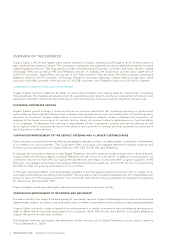Cogeco 2006 Annual Report Download - page 19
Download and view the complete annual report
Please find page 19 of the 2006 Cogeco annual report below. You can navigate through the pages in the report by either clicking on the pages listed below, or by using the keyword search tool below to find specific information within the annual report. Management’s Discussion and Analysis COGECO CABLE INC. 2006 17
In Portugal, Cogeco Cable’s subsidiary Cabovisão faces competition in its service areas mainly from incumbent
telecommunications carrier Portugal Telecom, SGPS, S.A. (PT) and its subsidiaries, from diversified Portuguese
conglomerate Sonae and ONI SGPS, S.A. (Sonae) and its subsidiaries, and from telecommunications operator ONI whose
main shareholder is Energias do Portugal (EDP), the incumbent electricity service provider in Portugal. In addition to the
national telephone network operator PT Communicações, PT owns TV Cabo, the largest cable broadband operator in
Portugal, which also offers a direct-to-home satellite television distribution service to the Portuguese market. Sonae owns
and operates the Clix and Novis services, which provide voice, data, and high speed Internet services respectively to the
residential and business markets. PT, Sonae and ONI provide mobile telecommunications services in Portugal, through
their respective subsidiaries as well as Vodaphone. Other competitors include AR Telecom (formerly known as Jazztel), Tele 2
and Redvo Telecom, a recently launched broadband microwave distribution service using Wi-Max technology. Until recently,
Cabovisão has been the only provider of full “triple-play” service bundles in its footprint, but Clix has recently launched a
digital video distribution service over telephone lines, and its competitive “triple-play” service bundles are expected
to extend progressively to approximately 60% of Cabovisão’s footprint. TV Cabo, has started offering digital telephone
services on Session Initiation Protocol (SIP) as well as a digital video service, and is thus also in a position to offer
competitive “triple-play” service bundles to approximately 60% of Cabovisão’s footprint. Cabovisão’s video distribution
services are analog only, and do not include true VOD at this time, but Cabovisão is actively considering the opportunity
and timing for the roll-out of its own digital services, as its HFC plant has the capacity to accommodate digital services
in addition to all its existing analog services.
The broadband telecommunications competitive landscape in Portugal differs from that prevailing in Canada mainly in
the following respects: the density of urban dwelling units within the Corporation’s footprint in Portugal is approximately
double that of its footprint in Canada, there is overlapping competitive cable plant over approximately 60% of Cabovisão’s
footprint and this competitive cable plant is presently controlled by the incumbent telephone company, but there is only one
Portuguese direct-to-home satellite competitor, and direct-to-home satellite service penetration is very limited in urban areas.
The level of piracy of video signals and the actual penetration of illicit reception of video distribution services in households
within the Corporation’s service areas may also have a signifi cant effect on the Corporation’s business and the competitiveness
of its service bundles.
TECHNOLOGICAL RISKS
The evolution of telecommunications technologies is very rapid, fuelled by a highly competitive global market for digital
content, consumer electronics and broadband products and services. The Corporation monitors the development of
technologies used for the transmission, distribution, reception and storage of data and their deployment by various
existing or potential competitors in the broadband telecommunications markets.
There are now several terrestrial and satellite transmission technologies available to deliver a range of electronic
communications services to the home with varying degrees of fl exibility and effi ciency, and they compete with cable
broadband telecommunications. While the broadband over power line (BPL) alternative has made little headway to date,
the competitive threat posed by other alternatives such as 3G and Wi-Max broadband wireless technologies, advanced
digital subscriber line technologies such as VDSL+, and the deployment of fi bre to the premises (FTTP) or close to the
premises (FTTN) by incumbent telephone companies is growing with each passing year.
On the other hand, cable telecommunications also continue to benefi t from rapid improvements, particularly in the areas
of modulation, digital compression, fractioning of optoelectronic links, multiplexing, HD distribution and switched video
distribution. Management of the Corporation remains of the view that broadband wireline distribution over fi bre and
coaxial cable will continue to be an effi cient, reliable, economical and competitive platform for the distribution of a full
range of electronic communications products and services for the foreseeable future. The competitiveness of the cable
broadband telecommunications platform will however continue to require additional capital investment on a timely basis
in an increasingly competitive and uncertain market environment.
























